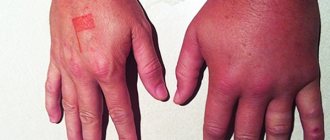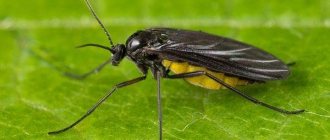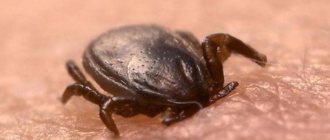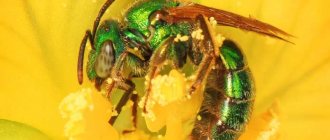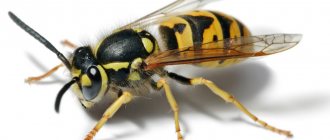Bumblebees are much more peaceful than many insects, even their closest relatives - bees.
But this does not mean that an encounter with a large, hairy insect is guaranteed to be without trouble. If you behave incorrectly, it is quite possible to provoke an attack and a bumblebee bite. You need to know how to act in this situation to avoid negative consequences.
Features of a bumblebee sting
Not every bumblebee can sting. The queen and working females have a sting, but nature has not endowed male bumblebees with this weapon. Despite the close family ties between bumblebees and bees, their sting is more like that of a wasp. It is absolutely smooth, without serrations that interfere with its release from the victim’s skin after a bite. This is why an insect can sting repeatedly without causing any harm to itself.
The inside of a bumblebee's sting is hollow. At the moment of the bite, poison passes through the canal and enters the victim’s blood.
Can bumblebees sting humans?
Initially, leisurely insects are not aggressive. The bumblebee is conditionally dangerous for humans, that is, its attack occurs under a certain set of circumstances:
- a threat to the safety of the colony or a danger to a specific insect;
- mechanical destruction of the nest;
- the smell of oxidizing metal, perfume, alcohol from a person (and old fumes are perceived even more aggressively);
- the predominance of deep blue shades in clothing or the environment;
- sudden movements in close proximity to the insect.
The sting of any bumblebee is different from the sting of bees. The latter have a jagged sting, so after a successful attack it remains in the victim’s body. The bumblebee’s “biting device” is smooth and freely removable. Therefore, the same bumblebee can sting people and animals multiple times.
Stinging attacks are carried out exclusively by female bumblebees. Only their mouthparts are equipped with a sting, inside of which there is poison from bombolithine, serines, phospholipase A2, a mixture of proteins and aliphatic compounds.
Males are also capable of defending themselves, but they use their mandibles. Although the bite is noticeable, due to the lack of poison it is harmless to people and animals.
The danger of a bumblebee bite
Having decided on the question of whether bumblebees bite, understanding that you need to be wary of females, you still shouldn’t be afraid of meeting them. However, it is better to behave carefully so as not to cause insect aggression.
Bumblebee sting
A bumblebee sting is quite painful, but does not pose a particular threat to the vast majority of people. It is dangerous only for allergy sufferers and people whose immune systems are not functioning properly.
In addition to an allergic reaction, the bite can cause itching. When scratching, dirt can get into the wound, which can cause infection.
The benefits and harms of a bumblebee sting
Apitherapy has been used in folk medicine since time immemorial, and in the 20th century, science confirmed the benefits of the technique. The object of scientific research was the venom of the domestic bee, but the biological similarity of stinging insects does not deny the healing power of bumblebee venom. The secret is useful for musculoskeletal pathologies:
- arthritis and arthrosis;
- radiculitis;
- tendovaginitis;
- joint contractures;
- sprains and inflammation of soft tissues.
Rubbing with ointments containing poison is effective for colds, bronchitis, and hypothermia. The unique composition of the poison stimulates the body's metabolic processes and increases defenses.
Like any toxic substance, the venom of stinging insects is used with caution. Well, in case of accidental bites (especially massive ones), there is no need to talk about treatment with bumblebee venom.
For a healthy person, a single bumblebee bite is not dangerous; the harm is noticeable with multiple attacks. If the victim is prone to allergic reactions or suffers from chronic diseases of the cardiovascular system and respiratory system, the likelihood of complications is high.
Possible reactions:
- slight malaise, headache, dizziness;
- low-grade fever;
- rashes like urticaria;
- gastrointestinal disorders.
Fact! When a bumblebee stings, it injects the victim with a fair amount of poison. The body responds to this by producing endogenous antidotes that have little toxicity. The more of these substances are produced, the more pronounced the consequences of the bite.
Do the bites of different types of bumblebees differ?
The composition of bumblebee venom may vary slightly depending on the species of the insect. The same factor largely influences the likelihood of an attack, as well as the painfulness of the bite. The most common types of bumblebees:
- garden - a small insect (up to 22 mm), non-aggressive, rarely bites, the bite is not very painful;
- black carpenter bumblebee - an insect with a black body and violet-blue wings, bites to protect the nest or in defense, the bite is quite painful;
- ground bumblebee - lives underground, preferring burrows left by rodents, bites very rarely;
- stone bumblebee - rather large insects (up to 3 cm) build nests in piles of stones; the poison can cause severe allergies.
City and field bumblebees also bite infrequently, the pain of the bite is moderate.
Types of bumblebees according to the toxicity of their poison
Over 300 species of these hymenopteran insects are known, and they are distributed throughout the globe. The exceptions are most regions of Africa and Australia. Bumblebees do not bite unless you touch them; they are peace-loving insects, but their venom is more toxic than that of bees.
The strength of the poison on the human body largely depends on the type of insect:
- Common bumblebee It has a black body with two yellow stripes on it. It nests in the ground and is a very rare member of the insect family, found only in western Europe and is a protected species.
- Forest. The smallest representative of the insect family under discussion. It also has less bright colors compared to other types of bumblebees. Their nests of moss and grass are found on the surface of the earth. Also, representatives of this type of insect inhabit abandoned rodent burrows.
- Purple bumblebee carpenter, a colorful insect, has a beautiful blue-black color and indigo wings. But he refers to bumblebees only by their names, which are given due to their external similarity. In fact, they are bees; their nests can be found in dry wood.
- Garden, a very large representative of this family of insects. The length of the female is about 25 mm. The color is bright and expressive, consists of three colors - black, yellow and white. For nesting, it occupies abandoned mouse holes.
- Earth bumblebee has a yellow stripe on the chest and a white tail. Female bumblebees reach a length of 19–23 mm.
Symptoms and appearance of the bite
After a person is stung by a bumblebee, the following symptoms are most often observed:
- sharp, rather severe pain, burning;
- compaction at the site of the bite;
- swelling.
The bumblebee bite itself looks like a red dot, around which the skin swells and turns red. The intensity and area of swelling and redness depend on the individual characteristics of the bitten person, as well as the period after which all traces will disappear. For some, everything goes away in a matter of hours, for others, healing is delayed for weeks.
Does a bumblebee bite or not: what to do if stung, medicines and folk remedies
The bumblebee, like bees and wasps, has a sting. This means that the insect can use it. The bumblebee itself is not aggressive, but there are situations in which it can still bite.
Bumblebee - does it bite or not?
A bumblebee can bite a person or animal, but will not attack first, unlike wasps. The insect may become aggressive if someone tries to “take away” the honey reserves, destroy the nest, or try to kill it. In this case, the individual will be obliged to use self-defense.
Various pungent odors can also cause irritation and aggression in insects. These include the smell of fumes or alcohol, strong perfumes or other cosmetics, and oxidized metal.
The smell of the latter can come from a watch or bracelet on your hand. Blue color is also an irritant for insects, therefore, when going into nature, where a large number of bumblebees can live, you need to take this factor into account.
Important! A mistake people make is waving their arms to ward off the bumblebee. Often this does not help, but on the contrary, it angers the insect even more.
What to do if bitten by a bumblebee?
The first thing you need to do is observe the wound and see the reaction. Do not worry if a swelling with redness forms at the site of the bite. This is a normal reaction to a bite, and you need to wait a little for the pain and itching to go away.
First aid at home
When a bee stings, it almost always leaves its stinger in the human body. After a bumblebee bite, the sting rarely remains, but if it does remain, you need to take tweezers, disinfect the instrument and carefully remove the sting.
After this, the area is treated with hydrogen peroxide. You can also use a solution of alcohol or ammonia. The products must be diluted with water in a ratio of 1:3 (alcohol) and 1:5 (ammonia).
It is possible to develop other symptoms that are more dangerous:
- upset stomach, nausea, vomiting;
- swelling;
- allergic reaction - the body becomes covered with red spots;
- difficulty breathing, suffocation;
- rapid heartbeat, shock;
- swelling of the mouth and/or larynx;
- severe itching of the skin.
All these signs indicate intolerance to bumblebee venom. If a person is not helped in time, there is a risk of death.
Medications
If complications occur, the first thing you need to do is take antihistamines. The main drugs include Suprastin, Tavegil and others. If the medications have helped partially and the symptoms include severe swelling, difficulty breathing and the overall condition is worsening, then you need to get help from a doctor as quickly as possible.
If this is not possible, stronger medications must be taken. These include drugs such as dexamethasone, hydrocortisone, etc.
In particularly advanced cases, adrenaline can also be administered, but this will require special equipment and skills.
Is a bumblebee bite dangerous: consequences
There is no danger as such from a bumblebee bite, but if the victim is allergic to the poison, then the consequences can be very serious.
In addition to unpleasant sensations (itching, swelling, pain, etc.), the victim may also fall into a coma or even die. Unpleasant consequences also await those who are bitten a large number of times.
What not to do if you are bitten by a bumblebee
If you are bitten, under no circumstances should you do the following:
- Kill an insect. The substances released by a killed bumblebee will be sensed by its relatives and will immediately come to their defense.
- Scratch and rub the wound. In this case, the spread of the poison will be more extensive and faster. It is better not to touch the bite site, as dirty hands can introduce infection through the hole made by the bumblebee.
- Drink alcoholic beverages. When drinking alcohol, the blood vessels dilate, and the poison spreads faster throughout the body.
- Cool the wound using available means such as water from a pond or leaves from a tree. These actions can lead to blood poisoning. The compress can only be made from clean water.
- Take sedatives or sleeping pills. These products increase the potency of toxic components.
Every person should know how to help with a bumblebee bite, since the consequences of bumblebee venom entering the body can be serious.
Localization of bites and greatest danger
The greatest danger from a bumblebee bite is if it strikes the neck or face. Swelling that develops after a bite to the neck can cause breathing problems. If an insect stings near the eye, in the lip, tongue or nasal mucosa, severe swelling makes it difficult for the affected organs to function normally. It is least dangerous if a bumblebee stings your finger, leg or arm.
shemale face
Classification of insects: which bumblebee can bite
The bumblebee is a profusely hairy and large bee. In Europe, there are 53 species of insects, which differ from each other in color and size. In addition, they are divided into 3 groups:
- Queens.
- Working insects.
- Drones.
Only a queen or a working bumblebee can sting. But these insects use their sting only for self-defense.
The most common types of European bumblebees are the following:
- Earthy. The largest bumblebee (up to 28 mm in length), the body is predominantly yellow in color with transverse stripes. The apex of the abdomen is white.
- Purple carpenter bumblebee. The length reaches up to 30 mm, the body is black and blue. The head and chest have a metallic sheen.
- Stone. It reaches 27 mm in length, the body is covered with black hairs. The tip of the abdomen is red.
- Garden. Its length is from 16 to 24 mm. The body has alternating areas of white, black and yellow.
Common species: purple carpenter bumblebee, ground bumblebee, stone bumblebee, garden bumblebee - photo gallery
Why are bites dangerous, including during pregnancy?
When bitten, poison is injected into the human body. In addition to itching, burning, swelling and redness, severe allergies or anaphylactic shock may occur, which in some cases can be fatal.
Numerous bites that occur simultaneously or in a short period of time are especially dangerous. The poison accumulated in a large volume leads to disruption of the functioning of the cardiovascular and nervous systems.
Bumblebee bites are especially dangerous for the fair sex during pregnancy and lactation. In the body of a woman carrying a child, some changes occur that increase susceptibility to the effects of various irritants. Also, the bites of these insects can have unpleasant consequences for people taking certain medications (from the list of beta blockers).
If a person stung by an insect already has a certain type of allergy, then the possibility of developing a negative reaction increases significantly. Very often children suffer from this, since their immune system is not yet strong enough.
Bite to the head, arm, leg, lips and other parts of the body
When bitten in the area of the cheeks, ear, neck, nose, eyes, as well as lips or tongue, the proper functioning of these organs is disrupted. A complication arises in the form of severe swelling, possibly even suffocation, in which it is often necessary to cut the front wall of the throat.
A bite of the limbs is considered the most harmless if the poison does not enter the bloodstream.
Relieving swelling
Bumblebee venom, once in the blood, spreads throughout the body. The immune system responds to a foreign substance by producing antibodies. They react with the toxin, resulting in the formation of new chemical compounds. They penetrate into the tissues, disrupt microcirculation, as a result of which fluid accumulates in the tissues - swelling is formed.
The best way to reduce swelling is to cool the affected area. You can also use folk or medicinal decongestants.
Recommendations for stinging insect bites
- If the sting remains in the body, you need to pull it out with treated tweezers. There is no need to try to squeeze it out with your fingers, so as not to infect the victim.
- The wound should be immediately treated with hydrogen peroxide, alcohol, vinegar, or cotton wool soaked in one of the listed products.
- Apply a piece of ice or a cold compress to the bite site, especially if it is around the eyes or other sensitive area. Cold will relieve swelling, reduce pain and slow down the absorption of poison. To extract the poison, you need to apply a piece of sugar moistened with water to the damaged area.
- The victim should be given plenty of liquid to drink, preferably hot tea with sugar. If the victim does not get better, or symptoms of an allergic reaction appear, then you should immediately call a doctor.
https://youtube.com/watch?v=dWlWKRx5v3A
Treatment of insect bites at home
In most cases, a bumblebee bite can be safely treated at home. For example, you can put a fresh leaf of plantain or parsley on the injured area and replace it with a new one every 2 hours.
You can apply a chopped onion, apple, raw potato to the damaged area, or chop 2 cloves of garlic, mix with honey and attach this mixture to the bite. The bandage must be changed twice a day.
Lemon juice and a compress made from it will also help.
Bumblebee sting
You can also dilute baking soda with water until a slurry forms and apply to the affected area, or prepare a solution of soda (1 teaspoon per glass of water), soak cotton wool in it and apply for a quarter of an hour.
Grind the activated carbon, add water until a paste forms, place it on the bite site and cover with film to prevent rapid drying.
If there is no activated carbon, apply validol moistened with water to the damaged area. You can also use medications, for example, Fenistil gel, which successfully relieves irritation. The damage should be lubricated with gel 3 times a day. The medicine begins to act immediately after application. If you are bitten by insects, you should not drink alcohol, as this leads to increased swelling.
Often people unwittingly provoke insects by waving their hands, trying to drive them away. This behavior, as well as the smell of perfume, alcohol, and fried meat, only attract and irritate bumblebees.
The smell of perfume attracts bumblebees
When should you go to the hospital?
- If several bumblebees or bees were bitten at the same time.
- When a child or elderly person is injured.
- If the bite occurs in the eyeball or mucous membrane of the mouth.
- When previous insect bites caused an allergic reaction.
- There are symptoms of infection: severe chills, swelling, pain, the bite site becomes purulent.
When a bumblebee bites, it is less painful than a bee or wasp sting because its venom is not as dangerous as that of a bee or wasp. In addition, a wasp can bite several times.
bumblebee nest
Conclusion on the topic
Knowing that bumblebees bite, do not provoke these insects. Try to avoid the places where their nests are located. Where bees, bumblebees or wasps are present in large numbers, it is undesirable to eat sweets, watermelons, melons, and drink sweet drinks.
Although bumblebees bite, there is no need to destroy them, because they pollinate plants well, and their honey contains protein, sucrose, many minerals and is very healthy.
In terms of pain, a bumblebee bite is even more unpleasant than a bee sting. Only the female can attack a person - she has a sting that she uses for defense. Even a single sting can be dangerous for humans. If you are unlucky enough to become a victim of several bumblebees, then acute toxic poisoning is guaranteed.
Treatment
Most people do not need special treatment after a bumblebee bite; all symptoms go away on their own in a fairly short time. And yet, to reduce pain, relieve redness and swelling, you can use medications and folk remedies.
Folk remedies
Our distant ancestors knew what to do after a bumblebee bite. Much of their advice is still relevant today. The following will help reduce discomfort:
- chopped plantain, parsley;
- aloe juice or freshly cut leaf;
- compress of grated onions;
- a slurry of soda mixed with water;
- lemon juice;
- a slice of fresh cucumber, lemon, sour apple, potato;
- chamomile decoction;
- a mixture of honey and chopped garlic.
Alcohol tincture of calendula or olive oil will help relieve swelling and redness.
Pills
To help a person bitten by a bumblebee, tablets, as strange as it may sound, are most often used externally. It is necessary to dissolve a tablet of activated carbon, aspirin or validol in water, and then moisten a cotton pad in the solution and apply it to the wound. This will soothe the pain and relieve swelling.
Antihistamines are taken internally: Suprastin, Tavegil, Citrine and others.
Ointments
Ointments and gels reduce burning, relieve redness and swelling. The most effective:
- Fenistil gel;
- Menovazin;
- balm “Star”;
- Rescuer;
- Psilo-balm;
- Levomekol.
Levomekol
Attention! It is strictly not recommended to use hormonal ointments without a doctor’s prescription.
Prevention
bumblebee nest
To avoid unpleasant encounters with bumblebees, you should know some rules. The instructions below will help you prevent these insect bites.
- The best way to avoid being bitten by bumblebees is to stay away from their habitats. Under no circumstances should you destroy the nests of these insects, as there is a possibility of falling under the wrath of an entire swarm.
- There is no need to walk barefoot on the grass, as you may inadvertently step on an insect hiding in the grass.
- If a bumblebee is flying near you, do not try to scare it away with sweeping movements. There is also no need to run away from the insect, this will attract its attention even more.
- Avoid bright clothes and strong perfumes when traveling outside the country.
- In summer and spring, use mosquito nets.
- Prevention also includes having a first aid kit equipped with everything necessary to provide first aid and knowledge of the dangers of bumblebee bites and what to do if you are bitten.
Video on the topic
How dangerous is an allergic reaction?
The bumblebee is dangerous because at the time of the bite it injects a toxic substance into the wound, which causes intoxication of the body. But the main health threat is a possible allergic reaction to the toxin. The degree of intensity may vary depending on the individual characteristics of the person. Allergy symptoms:
- extensive swelling extending far beyond the affected area;
- the appearance of a rash on the body;
- nausea, vomiting;
- diarrhea;
- difficulty breathing, suffocation;
- heart rhythm disturbance;
- fever, chills.
In severe cases, convulsions, loss of consciousness, and anaphylactic shock are observed.
An allergic reaction to bumblebee venom that enters the body may not appear immediately, but usually it occurs quite quickly within a maximum of 1.5 hours after the bite.
Does it attack a person?
Seeing a large bee-like insect, many people get scared, not knowing whether bumblebees bite people. On their own initiative, they do not attack a person unless there are aggressive actions on his part.
Having seen a bumblebee nest near their home, many try to get rid of the insect, not only by fumigating them with smoke, but also by destroying the “houses”.
Note! You should not try to catch bumblebees with your hands. Even the male is able to stand up for himself, biting through the palm with his sharp jaws.
Can a bumblebee bite a person on its own initiative?
This is possible in 2 cases:
- if the clothes are blue, for some reason this shade is dangerous for insects; therefore, one can expect an inadequate reaction; although the sting practically does not pierce the fabric itself, the insect can injure an open area of the body;
- Bumblebees are aggressive towards the smells of alcohol, fumes, perfumes and tobacco; this can become a reason for an attack by a whole swarm of insects that find themselves in close proximity.
Sometimes bee relatives are irritated by the smell of oxidized metal. This “aroma” of the body arises from constantly wearing watches with bracelets and jewelry. The metal oxidizes under the influence of sweat secreted by the skin, which is quite typical for the hot season.
Bumblebees are also attracted by the smell of fried meat, watermelons, melons, and sweet drinks. Therefore, it is not recommended to have picnics near insect homes, so as not to brush off the annoying invasion later. This unnerves the bumblebees and can become a reason for an attack.
Bumblebees are also attracted by the smell of fried meat, watermelons, melons, and sweet drinks.
If a person does suffer, it is advisable to take immediate action, even if there is no tendency to allergies:
- apply fresh parsley or plantain leaf to the injured area, changing the compress every 2 hours until the swelling subsides;
- Dressings with pieces of apple, raw potatoes, onions mixed with honey help well;
- you can periodically treat the wound with lemon juice;
- Traditional healers recommend making compresses with soda solution, activated carbon slurry or validol.
If the bite is in a sensitive area (for example, in the eye area), it is better to use cold compresses or ice cubes. This will help relieve pain, relieve swelling and slow down the absorption of poison.
Additional Information. A compress using refined sugar moistened with water can remove bumblebee toxin from a wound.
You should not drink alcohol after a bite - alcohol will only intensify the allergic reaction. But hot sweet tea and plenty of liquid will be welcome.
In some cases, it is more rational to seek medical help:
- if several bumblebees are stung at once;
- when the bite was in the throat area, oral mucosa or eyeball;
- if an elderly person or child is injured;
- in the presence of severe pain, swelling, suppuration and chills.
Bumblebee bites
Pay attention! If the victim is allergic, after contact with a bumblebee you should not wait for the body’s reaction, but immediately consult a doctor.
It is most dangerous if there was not just one bite, but several individuals. In this case, the amount of poison entering the body from the sting increases many times, and the internal systems have difficulty coping with intoxication.
Such situations are rare, because bumblebees usually do not attack in a flock. More often this happens if there have been attempts to destroy the insect nest. Even when it was accidentally touched, bumblebees will not figure it out; their self-preservation instinct turns on.
You should not hunt for wild honey produced by bumblebees - its taste is in many ways inferior to that of bees. But attempts at such penetrations can have disastrous consequences.
When is a doctor needed?
In some situations, a person’s life after a bumblebee bite is in serious danger and only qualified medical assistance can help. Consultation with a doctor is required in the following cases:
- the insect stung a small child, a pregnant woman, a person with a predisposition to allergies;
- bite site - face, neck;
- multiple bites;
- a person experiences symptoms of intoxication (severe, rapidly spreading swelling, nausea, lethargy, dizziness, loss of consciousness).
A doctor’s help is also needed if the wound becomes infected, when the affected area becomes inflamed and suppuration appears.
Helping a child after a bite
The injured child must be shown to a doctor, and before that a number of pre-medical measures must be taken:
- inspect the wound and rinse with boiled water and antiseptic;
- if there are no signs of complications, treat the bite with medical alcohol, a weak solution of potassium permanganate, or chlorhexidine;
- Apply a cold compress to the injury;
- even in the absence of allergies, give an antihistamine - Suprastin, Zodak, Tavegil in the dosage according to the attached instructions.
After treating the affected area, put the child to bed and give a warm drink every hour and a half.
How to prevent bumblebee bites?
Following some recommendations will help to significantly reduce the risk of being stung by a bumblebee:
- you should not try to catch an insect or drive it away by waving your arms;
- it is undesirable to be near a bumblebee nest, much less perform any manipulations with it;
- Don’t eat sweets outside that attract insects;
- When in nature, it is better to dress in clothes of soothing colors and not use perfumes with a cloying, pungent aroma.
If bumblebees appear on your property from time to time, you should not immediately think about how to get rid of them. Peaceful coexistence with these insects is quite possible.
Do bumblebees bite? Let's find out
The bumblebee belongs to the genus of Hymenoptera insects and is part of the family of true bees. Its body structure and lifestyle are almost the same as those of ordinary honey bees. “Do bumblebees bite?” – this question probably interested many people. The bumblebee is brightly colored and relatively large in size for an insect. Dense short hairs cover its dense body, which is usually black with bright yellow stripes. In the lower part of the insect's body, which is white in color, there is a small sting, usually invisible. The body of a bumblebee can reach a length of three centimeters. Let's find out in more detail about the life of this amazing insect and, finally, determine whether bumblebees bite or not.
Aggressive and dangerous - these are not entirely true signs that a bumblebee has in the minds of most people. What is he really like? The bumblebee is a beneficial insect that is a valuable pollinator. These amazing insects have a longer proboscis (its length can reach 9.5 millimeters) than bees. Therefore, they have the ability to pollinate, for example, plants such as red clover, which bees cannot pollinate. Bumblebees have thick hair, which allows them to pollinate flowers in fairly cold times, collecting nectar and pollen. The collected nectar serves as a source of nutrition for the offspring, while bumblebees, unlike bees, do not store honey for the winter. Do bumblebees, hardworking and seemingly peaceful insects, bite?
The bumblebee (photo on the right) has the same sting as wasps and bees. However, he uses it quite rarely, since bumblebees are quite peaceful insects. Only working bumblebees and the queen have a stinging apparatus, which is intended for protection. When a bumblebee bites, a small amount of bumblebee venom enters the human body. Afterwards, a short pain is felt, and sometimes allergic reactions may occur. So the answer to the question of whether bumblebees bite or not is yes, but these insects sting very rarely. The sting of a bumblebee and a wasp does not have serrations, that is, it is typical for the queen and working bumblebees to extract it. The stung area swells significantly, itching and redness appear, which can last for several hours.
To prevent bumblebee bites, there are certain preventive measures that should be taken by both adults and children in particular. If you come into contact with these insects, do not try to pick them up. Remain calm, do not forcefully wave away the bumblebee flying around, thereby leading it into an excited state. Do not touch bumblebee nests. Remember that strong foreign odors (perfumes, alcohol, scented soaps and others) can cause aggressive behavior of the insect. When wearing thick clothing, the likelihood of a bumblebee bite is significantly reduced, since it cannot sting through it. For safety reasons, it is necessary to exercise caution and not allow children to catch or handle a bright, but still dangerous insect.
fb.ru


